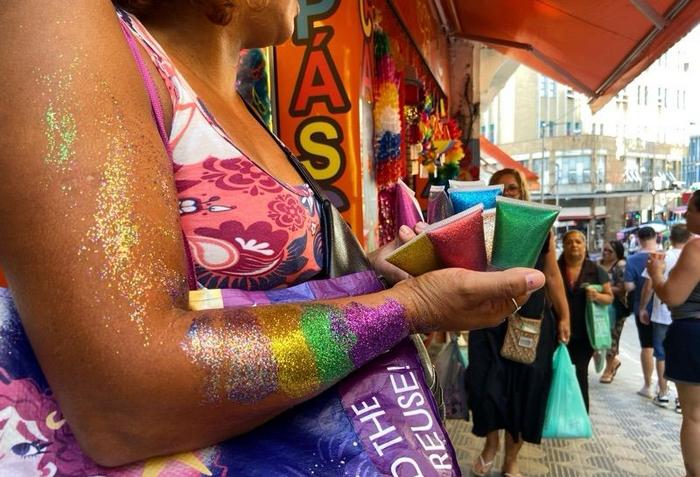Glitter is used in a wide array of colors and shapes in apparel, footwear, cosmetics, makeup, handbags, festive decorations, arts and crafts, and jewelry, among many other applications. During the Carnival holidays, hundreds of thousands of Brazilians cover parts of their bodies with it while dancing in the streets. Its brilliance is dazzling but it is considered an emerging pollutant by many scientists: like other microplastics (small plastic pieces less than 5 mm long), it is not filtered by wastewater treatment plants and ends up in rivers and the sea, interfering with aquatic life in various ways.

Credit: Daniel Antônio/Agência FAPESP
Glitter is used in a wide array of colors and shapes in apparel, footwear, cosmetics, makeup, handbags, festive decorations, arts and crafts, and jewelry, among many other applications. During the Carnival holidays, hundreds of thousands of Brazilians cover parts of their bodies with it while dancing in the streets. Its brilliance is dazzling but it is considered an emerging pollutant by many scientists: like other microplastics (small plastic pieces less than 5 mm long), it is not filtered by wastewater treatment plants and ends up in rivers and the sea, interfering with aquatic life in various ways.
A study conducted at the Federal University of São Carlos (UFSCar) with FAPESP’s support detected an additional problem: besides plastic, glitter contains metals, typically aluminum, and according to the findings of the study, reported in the New Zealand Journal of Botany, these can hinder the underwater passage of light sufficiently to impair aquatic plant photosynthesis and growth.
The authors of the article focus on the Large-flowered waterweed Egeria densa, a macrophyte (aquatic plant) native to Argentina, Brazil and Uruguay. Macrophytes are visible to the naked eye, serving as food and shelter for many species, providing shade and producing oxygen. They are a key component of biofilters in phytoremediation projects that use plants to detoxify soil, water or air. Some, including E. densa, are widely used for oxygenation and landscaping in aquariums and artificial lakes.
The researchers analyzed the action of glitter in laboratory experiments involving 400 fragments of E. densa incubated in flasks containing water from the Monjolinho reservoir on the campus at UFSCar and common glitter of the type available from retail stores, with an average particle surface area of 0.14 mm2.
They tested four combinations: E. densa in the presence of glitter at 0.04 grams per liter, with and without light; and E. densa in the absence of glitter, with and without light, as control. They analyzed photosynthesis rates using the “light and dark flask” method developed in 1927 and widely used in this type of study. In the light flask, the plant undergoes photosynthesis, producing oxygen as a byproduct. The dark flask is used to measure respiration, where the plant consumes oxygen. The net rate of photosynthesis is determined by comparing the rates of gas exchange in the light and dark flasks.
The experiment showed that photosynthesis rates were 1.54 times higher in the absence of glitter. The reason was that the microplastic particles reduced the amount of light in the water. Respiration was also affected, but not as significantly.
“These findings support the hypothesis we began with, which was that glitter interferes with photosynthesis, possibly owing to the reflection of light by the microplastic particles’ metallic surface,” said Luana Lume Yoshida, first author of the article. The study was part of her scientific initiation project at the Bioassay and Mathematical Modeling Laboratory (LBMM) in UFSCar’s Department of Hydrobiology. Yoshida is currently researching there for a master’s degree in ecology and natural resources.
Sustainable Carnival
“In this experiment, we specifically observed the physical interference of glitter in a species of macrophyte, but there are better-known references in the scientific literature to water contamination and consumption of these particles by other aquatic organisms. We put all the pieces of the puzzle together and were able to describe the functioning of the entire ecosystem, as well as pointing out what can happen throughout the food chain. That’s the key difference of an ecological approach,” said Marcela Bianchessi da Cunha-Santino, last author of the article and one of LBMM’s principal investigators.
“With a robust ‘database’, we’ll be able to think about public policy to foster more conscious consumption of this type of material, but for now it’s important to warn society that changes in photosynthesis rates, however remote they may seem from our lives, are linked to other changes that affect us more directly, such as the decrease in primary production by food chains in aquatic environments [i.e. organisms at the bottom of the food chain]. If there are more sustainable alternatives to glitter, why not switch to these right away?” said Irineu Bianchini Jr., the other co-author of the article and also a PI at LBMM.
About São Paulo Research Foundation (FAPESP)
The São Paulo Research Foundation (FAPESP) is a public institution with the mission of supporting scientific research in all fields of knowledge by awarding scholarships, fellowships and grants to investigators linked with higher education and research institutions in the State of São Paulo, Brazil. FAPESP is aware that the very best research can only be done by working with the best researchers internationally. Therefore, it has established partnerships with funding agencies, higher education, private companies, and research organizations in other countries known for the quality of their research and has been encouraging scientists funded by its grants to further develop their international collaboration. You can learn more about FAPESP at www.fapesp.br/en and visit FAPESP news agency at www.agencia.fapesp.br/en to keep updated with the latest scientific breakthroughs FAPESP helps achieve through its many programs, awards and research centers. You may also subscribe to FAPESP news agency at http://agencia.fapesp.br/subscribe.
Journal
New Zealand Journal of Botany
DOI
10.1080/0028825X.2023.2276284
Article Title
Interference of glitter with the photosynthetic rates of a submerged macrophyte, Egeria densa
Article Publication Date
29-Nov-2023




